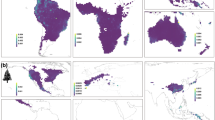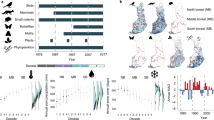Abstract
Predicting the consequences of climate change for biodiversity is critical to conservation efforts1,2,3. Extensive range losses have been predicted for thousands of individual species4, but less is known about how climate change might impact whole clades1 and landscape-scale patterns of biodiversity5. Here, we show that climate change scenarios imply significant changes in phylogenetic diversity and phylogenetic endemism at a continental scale in Australia using the hyper-diverse clade of eucalypts. We predict that within the next 60 years the vast majority of species distributions (91%) across Australia will shrink in size (on average by 51%) and shift south on the basis of projected suitable climatic space. Geographic areas currently with high phylogenetic diversity and endemism are predicted to change substantially in future climate scenarios. Approximately 90% of the current areas with concentrations of palaeo-endemism6 (that is, places with old evolutionary diversity) are predicted to disappear or shift their location. These findings show that climate change threatens whole clades of the phylogenetic tree, and that the outlined approach can be used to forecast areas of biodiversity losses and continental-scale impacts of climate change.
This is a preview of subscription content, access via your institution
Access options
Subscribe to this journal
Receive 12 print issues and online access
$209.00 per year
only $17.42 per issue
Buy this article
- Purchase on Springer Link
- Instant access to full article PDF
Prices may be subject to local taxes which are calculated during checkout



Similar content being viewed by others
References
Thuiller, W. et al. Consequences of climate change on the tree of life in Europe. Nature 470, 531–534 (2011).
Araujo, M. B., Thuiller, W. & Pearson, R. G. Climate warming and the decline of amphibians and reptiles in Europe. J. Biogeogr. 33, 1712–1728 (2006).
Purvis, A. & Hector, A. Getting the measure of biodiversity. Nature 405, 212–219 (2000).
Hof, C., Araujo, M. B., Jetz, W. & Rahbek, C. Additive threats from pathogens, climate and land-use change for global amphibian diversity. Nature 480, 22–29 (2011).
Warren, R. et al. Quantifying the benefit of early climate change mitigation in avoiding biodiversity loss. Nat. Clim. Change 3, 678–682 (2013).
Mishler, B. D. et al. Phylogenetic measures of biodiversity and neo- and paleo-endemism in Australian Acacia. Nat. Commun. 5, 4473 (2014).
Faith, D. P. & Richards, Z. T. Climate change impacts on the tree of life: changes in phylogenetic diversity illustrated for Acropoda corals. Biology 1, 906–932 (2012).
Loyola, R. D. et al. Clade-specific consequences of climate change to amphibians in Atlantic Forest protected areas. Ecography 37, 65–72 (2014).
Faith, D. P. & Pollock, L. J. Phylogenetic diversity and the sustainable use of biodiversity. in Applied Ecology and Human Dimensions in Biological Conservation (eds Verdade, L. M. et al.) 35–52 (Springer, 2014).
Faith, D. P. Conservation evaluation and phylogenetic diversity. Biol. Cons. 61, 1–10 (1992).
Faith, D. P. et al. Evosystem services: an evolutionary perspective on the links between biodiversity and human-well-being. Curr. Opin. Environ. Sustain. 2, 66–74 (2010).
Cadotte, M. W. et al. Phylogenetic diversity metrics for ecological communities: integrating species richness, abundance and evolutionary history. Ecol. Lett. 13, 96–105 (2010).
Rosauer, D., Laffan, S. W., Crisp, M. D., Donnellan, S. C. & Cook, L. G. Phylogenetic endemism: a new approach for identifying geographical concentrations of evolutionary history. Mol. Ecol. 18, 4061–4072 (2009).
González-Orozco, C. E., Thornhill, A. H., Knerr, N., Laffan, S. & Miller, J. T. Biogeographical regions and phytogeography of the eucalypts. Diversity Distrib. 20, 46–58 (2014).
Wilson, P. G. in Myrtaceae. The Families and Genera of Vascular Plants. Volume X. Flowering Plants Eudicots: Sapindales, Cucurbitales, Myrtaceae (ed. Kubitzki, K.) 212–271 (Springer, 2011).
Thornhill, A. H., Ho, S. Y. W., Külheim, C. & Crisp, M. D. Interpreting the modern distribution of Myrtaceae using a dated molecular phylogeny. Mol. Phylogenet. Evol. 93, 29–43 (2015).
Thornhill, A. H., Popple, L. W., Carter, R. J., Ho, S. Y. W. & Crisp, M. D. Are pollen fossils useful for calibrating relaxed molecular clock dating of phylogenies? A comparative study using Myrtaceae. Mol. Phylogen. Evolut. 63, 15–27 (2012).
Crisp, M. D., Burrows, G. E., Cook, L. G., Thornhill, A. H. & Bowman, D. M. J. S. Flammable biomes dominated by eucalypts originated at the Cretaceous-Palaeogene boundary. Nat. Commun. 2, 1–8 (2011).
Bayly, M. J. et al. Chloroplast genome analysis of Australian eucalypts-Eucalyptus Corymbia Angophora Allosyncarpia and Stockwellia (Myrtaceae). Mol. Phylogen. Evolut. 69, 704–716 (2013).
Booth, T. H. et al. Native forest and climate change: lessons from eucalypts. Forest Ecol. Manage. 347, 18–29 (2015).
Hughes, L., Cawsey, E. M. & Westoby, M. Climatic range sizes of Eucalyptus species in relation to future climate change. Glob. Ecol. Biogeogr. Lett. 5, 23–29 (1996).
Butt, N., Pollock, L. J. & McAlpine, C. A. Eucalypts face increasing climate stress. Ecol. Evolut. 3, 5011–5022 (2013).
Myers, N., Mittermeier, R. A., Mittermeier, C. G., da Fonseca, G. A. B. & Kent, J. Biodiversity hotspots for conservation priorities. Nature 403, 853–858 (2000).
Eiserhardt, W. L., Borchsenius, F., Plum, C. M., Ordoñez, A. & Svening, J.-C. Climate-driven extinctions shape the phylogenetic structure of temperate tree floras. Ecol. Lett. 18, 263–272 (2015).
Willis, C. G. et al. Phylogenetic patterns of species loss in Thoreau’s woods are driven by climate change. Proc. Natl Acad. Sci. USA 105, 17029–17033 (2008).
Forest, F. et al. Preserving the evolutionary potential of floras in biodiversity hotspots. Nature 445, 757–760 (2007).
Thornhill, A. H. et al. Continental-scale spatial phylogenetics of Australian angiosperms provides insights into ecology, evolution and conservation. J. Biogeogr. http://dx.doi.org/10.1111/jbi.12797 (2016).
Zhang, J., Nielsen, S. E., Stolar, J., Chen, Y. & Thuiller, W. Gains and losses of plant species and phylogenetic diversity for a northern high-latitude region. Diversity Distrib. 21, 1441–1454 (2015).
Cardinale, B. J. et al. Biodiversity loss and its impact on humanity. Nature 486, 59–67 (2012).
Hoffmann, A. A. & Sgro, C. M. Climate change and evolutionary adaptation. Nature 470, 479–485 (2011).
Euclid v3.0—Eucalypts of Australia Centre for Plant Biodiversity Research, Lucid, Australian Government, CSIRO (2016); https://www.anbg.gov.au/cpbr/cd-keys/euclid3/euclidsample/html/index.htm
Kujala, H., Moilanen, A., Araújo, M. B. & Cabeza, M. Conservation planning with uncertain climate change projections. PLoS ONE 8, e53315 (2013).
Williams, K. J. et al. Harnessing Continent-Wide Biodiversity Datasets for Prioritising National Conservation Investment CSIRO Ecosystem Sciences, Canberra (A report prepared for the Department of Sustainability, Environment, Water, Population and Communities, Australian Government, Canberra, 2010).
McKenzie, N. J., Jacquier, D. W., Ashton, L. J. & Cresswell, H. P. Estimation of Soil Properties Using the Atlas of Australian Soils (CSIRO, Canberra, 2000).
Elith, J. et al. A statistical explanation of Maxent for ecologists. Diversity Distrib. 17, 43–57 (2011).
Pollock, L. J. et al. Phylogenetic diversity meets conservation policy: small areas are key to preserving eucalypt lineages. Phil. Trans. R Soc. B 370, 1662 (2015).
Phillips, S. J. & Dudik, M. Modeling of species distributions with Maxent: new extensions and a comprehensive evaluation. Ecography 31, 161–175 (2008).
Edgar, R. C. MUSCLE: multiple sequence alignment with high accuracy and high throughput. Nucleic Acids Res. 32, 1792–1797 (2004).
Rambaut, A. Sequence Alignment Editor (Se-Al) v2.0 (2002); http://tree.bio.ed.ac.uk/software/seal
VanDerWal, J. et al. Focus on poleward shifts in species’ distribution underestimates the fingerprint of climate change. Nat. Clim. Change 3, 239–243 (2013).
Cremer, K. W. Distance of seed dispersal in eucalypts estimated from seed weights. Aust. Forest Res. 7, 225–228 (1977).
Laffan, S. W., Lubarsky, E. & Rosauer, D. F. Biodiverse, a tool for the spatial analysis of biological and related diversity. Ecography 33, 634–647 (2010).
Ferrier, S., Manion, G., Elith, J. & Richardson, K. Using generalized dissimilarity modelling to analyse and predict patterns of beta diversity in regional biodiversity assessment. Diversity Distrib. 13, 252–264 (2007).
Acknowledgements
We acknowledge the National Environmental Research Program (NERP) for workshop funding, the Bjarne K Dahl Trust for support, and the ARC grant DP130101141 for supporting the eucalypts phylogenetic work. B.D.M. acknowledges a Visiting Fellowship from the Collaborative Research Network for Murray-Darling Basin Futures, University of Canberra in 2013. S.L. was supported by ARC DECRA DE130100565. This manuscript includes work carried out by J.T.M. while serving at the National Science Foundation. The views expressed in this paper do not necessarily reflect those of the National Science Foundation or the United States Government.
Author information
Authors and Affiliations
Contributions
All authors contributed to project conception. C.E.G.-O., L.J.P., A.H.T., N.K., B.G. and S.W.L. conducted analyses. A.H.T., M.D., C.K. and J.T.M. developed the phylogeny. A.H.T., N.K., C.E.G.-O., L.J.P. and N.B. compiled and corrected species spatial data records. C.E.G.-O. wrote the manuscript draft and all authors contributed to interpretation of the results and writing of the final paper.
Corresponding authors
Ethics declarations
Competing interests
The authors declare no competing financial interests.
Supplementary information
Supplementary Information
Supplementary Information (PDF 7044 kb)
Supplementary Information
Supplementary Information (PDF 763 kb)
Supplementary Information
Supplementary Information (PDF 23277 kb)
Rights and permissions
About this article
Cite this article
González-Orozco, C., Pollock, L., Thornhill, A. et al. Phylogenetic approaches reveal biodiversity threats under climate change. Nature Clim Change 6, 1110–1114 (2016). https://doi.org/10.1038/nclimate3126
Received:
Accepted:
Published:
Issue Date:
DOI: https://doi.org/10.1038/nclimate3126
This article is cited by
-
Comparison of phylogenetic and taxonomic diversity of pitcher plant bogs in Georgia’s Coastal Plain
Plant Ecology (2023)
-
Evaluation of animal and plant diversity suggests Greenland’s thaw hastens the biodiversity crisis
Communications Biology (2022)
-
Amphibian phylogenetic diversity in the face of future climate change: not so good news for the chilean biodiversity hotspot
Biodiversity and Conservation (2022)
-
Spatial variation and mechanisms of leaf water content in grassland plants at the biome scale: evidence from three comparative transects
Scientific Reports (2021)
-
Rapid climate change results in long-lasting spatial homogenization of phylogenetic diversity
Nature Communications (2020)



